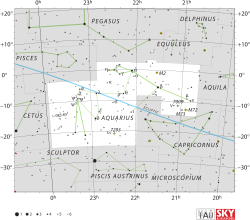39 Aquarii
| 39 Aquarii | |
 | |
| Observationsdata Epok: J2000.0 | |
|---|---|
| Stjärnbild | Vattumannen |
| Rektascension | 22t 12m 25,76309s[1] |
| Deklination | -14° 11′ 38,3009″[1] |
| Skenbar magnitud () | +6,03[2] |
| Stjärntyp | |
| Spektraltyp | F0 V[3] |
| U–B | +0,00[4] |
| B–V | +0,38[2] |
| Astrometri | |
| Radialhastighet () | +15,2[5] km/s |
| Egenrörelse (µ) | RA: +23,89[6] mas/år Dek.: -47,43[6] mas/år |
| Parallax () | 22,5378 ± 0,1723[1] |
| Avstånd | 145 ± 1 lå (44,4 ± 0,3 pc) |
| Absolut magnitud () | 2,92[7] |
| Detaljer | |
| Massa | 1,35[8] M☉ |
| Radie | 1,79+0,04-0,10[6] R☉ |
| Luminositet | 6,109 ± 0,054[1] L☉ |
| Temperatur | 6 806[3] K |
| Metallicitet | -0,21[3] dex |
| Ålder | 1,8[7] miljarder år |
| Andra beteckningar | |
| BD-14 6229, GSC 05809-00416, HD 210705, HIC 109624, HIP 109624, HR 8462, 2MASS J22122575-1411384, NSV 14068, PPM 239931, SAO 164923, TD1 28853, TYC 5809-416-1, uvby98 100210705, WDS J22124-1412AB, Gaia DR2 2600144755430782592 [4] | |
39 Aquarii, som är stjärnans Flamsteed-beteckning, är en ensam stjärna belägen i den mellersta delen av stjärnbilden Vattumannen. Den har en skenbar magnitud på 6,03 [2] och är mycket svagt synlig för blotta ögat där ljusföroreningar ej förekommer. Baserat på parallaxmätning inom Hipparcosuppdraget på ca 22,5[1] mas, beräknas den befinna sig på ett avstånd på ca 145 ljusår (ca 44 parsek) från solen. Den rör sig bort från solen med en heliocentrisk radialhastighet på ca 15 km/s.[5]
Egenskaper
[redigera | redigera wikitext]39 Aquarii är en gul till vit stjärna i huvudserien av spektralklass F0 V.[3] Den har en massa som är ca 35 procent[8] större än solens massa, en radie som är ca 1,8[6] gånger större än solens och utsänder från dess fotosfär ca 6[1] gånger mera energi än solen vid en effektiv temperatur av ca 6 800[3] K.
39 Aquarii har en visuell följeslagare av magnitud 9,3 med en vinkelavskiljning från huvudstjärnan med 0,6 bågsekunder vid en positionsvinkel på 257°.[9]
Se även
[redigera | redigera wikitext]Referenser
[redigera | redigera wikitext]- Den här artikeln är helt eller delvis baserad på material från engelskspråkiga Wikipedia, 39 Aquarii, 8 november 2019.
Noter
[redigera | redigera wikitext]- ^ [a b c d e f] Brown, A. G. A.; et al. (Gaia collaboration) (August 2018). "Gaia Data Release 2: Summary of the contents and survey properties". Astronomy & Astrophysics. 616. A1. arXiv:1804.09365. Bibcode:2018A&A...616A...1G. doi:10.1051/0004-6361/201833051. Gaia DR2 record for this source at VizieR.
- ^ [a b c] Corben, P. M.; Stoy, R. H. (1968), "Photoelectric Magnitudes and Colours for Bright Southern Stars", Monthly Notes of the Astronomical Society of Southern Africa, 27: 11, Bibcode:1968MNSSA..27...11C.
- ^ [a b c d e] Cenarro, A. J.; et al. (January 2007), "Medium-resolution Isaac Newton Telescope library of empirical spectra - II. The stellar atmospheric parameters", Monthly Notices of the Royal Astronomical Society, 374 (2): 664–690, arXiv:astro-ph/0611618, Bibcode:2007MNRAS.374..664C, doi:10.1111/j.1365-2966.2006.11196.x.
- ^ [a b] "* 39 Aqr". SIMBAD. Centre de données astronomiques de Strasbourg. Hämtad 2012-07-16.
- ^ [a b] Wilson, Ralph Elmer (1953), General catalogue of stellar radial velocities, Carnegie Institution of Washington, Bibcode:1953GCRV..C......0W.
- ^ [a b c d] van Leeuwen, F. (November 2007), "Validation of the new Hipparcos reduction", Astronomy and Astrophysics, 474 (2): 653–664, arXiv:0708.1752, Bibcode:2007A&A...474..653V, doi:10.1051/0004-6361:20078357.
- ^ [a b] Nordström, B.; et al. (May 2004), "The Geneva-Copenhagen survey of the Solar neighbourhood. Ages, metallicities, and kinematic properties of ˜14 000 F and G dwarfs", Astronomy and Astrophysics, 418 (3): 989–1019, arXiv:astro-ph/0405198, Bibcode:2004A&A...418..989N, doi:10.1051/0004-6361:20035959.
- ^ [a b] David, Trevor J.; Hillenbrand, Lynne A. (2015), "The Ages of Early-Type Stars: Strömgren Photometric Methods Calibrated, Validated, Tested, and Applied to Hosts and Prospective Hosts of Directly Imaged Exoplanets", The Astrophysical Journal, 804 (2): 146, arXiv:1501.03154, Bibcode:2015ApJ...804..146D, doi:10.1088/0004-637X/804/2/146.
- ^ Fabricius, C.; Makarov, V. V. (April 2000), "Two-colour photometry for 9473 components of close Hipparcos double and multiple stars", Astronomy and Astrophysics, 356: 141–145, Bibcode:2000A&A...356..141F.





